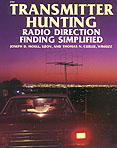
 Back to the Homing In home page
Back to the Homing In home page
Over the years, there have been several other sources of Roanoke Doppler circuit boards and kits. The following list may help you identify these legacy boards/kits. Links to documentation are provided where available. If you have Roanoke Doppler board/kit documentation that I do not have, please advise by e-mail.
Sources for RF attenuator projects
Resistive RF attenuators are best suited for mobile HF and VHF T-hunting with directional antennas such as loops, yagis and quads. Pete Ostapchuk N9SFX sells parts for resistive attenuators, including a 6-section enclosure machined from 6061-T6 aluminum bar stock and engraved with attenuation values. Also available from him are switches, resistors and connectors. Plans for his project are in QST Magazine for May 1998. Send e-mail to n9sfx@aol.com for details and prices. The above disclaimer applies.
Another source of resistive RF attenuators is National RF, Incorporated (formerly Radio Engineers) of San Diego, CA.
For on-foot VHF/UHF "sniffing" and international-style foxhunting with a beam and handi-talkie or scanner, an "offset" or "active" attenuator is better because it eliminates the problem of signal leakage directly into the receiver's case. Plans for an active attenuator are at this Homing In site, click here. Parts are available at local suppliers, including Radio Shack.
Suitable PIN diodes include:
Philips NTE555 or ECG555 -- "Replacement" type semiconductor available at local electronics parts houses all over the country. Even some giant computer stores such as Fry's Electronics carry NTE parts. Priced $1.50 to $2.00 each. This is an older part with tab leads and unspecified series RF resistance.
For more information about sealed RF "piston" trimmer capacitors and sources, see the Shrunken Quad page at this site.
Ferrite beads and cores for the dual-polarization quad and other RF projects are available by mail order from Amidon Associates.
ByteMark Corporation, 7714 Trent Street Orlando, FL 32807 (407) 679-3184 also carries Amidon ferrite components and has technical information about Amidon ferrite and iron powder products on its Web site. In addition, ByteMark sells a Windows-based program for calculating the turns for coils on various Amidon cores.
The Philmore line of packaged electronic parts includes unusual items such as Amidon T50-6 cores (used in the ATX80 80-meter fox transmitter), International Rectifier HEXFETs, MPF-102 JFETs, etc. Unfortunately the Philmore Web site does not have a complete product list, but it does include a list of local distributors of these parts.
Crystals for 80-meter foxboxes are available from Brian Carling AF4K in Sanford, FL. He also sells some crystal-can oscillators that may be suitable for building offset attenuators.
Jerry Boyd WB8WFK provides this feedback on ON7YD's Fox Transmitter for 80 meters (ATX80), which was featured in 73 Magazine for November 2000: "Motorola MC14001B Quad-NOR ICs from Radio Shack (part number 276-2401) didn't work. The oscillator would not start properly. I tried 6 different ones
and they all acted the same. I put in an old Fairchild CD4001B Quad-NOR and now it works with no problem. I downloaded data sheets from the manufacturers' Web sites and the internal schematics are indeed different." Fairchild ICs are available from many suppliers, including Digi-Key. KØOV's six transmitters use Signetics (Philips) CD4001B's packaged by Jim-Pak and sold by local parts suppliers nationwide -- they all work fine.
Sources for building polar-plot bearing readouts
I have many requests for sources of unusual electromechanical parts used in two-dimensional bearing indicators such as the KK6CU
motorized quad, the WB8WFK and KD6IFZ computer displays, and the NØMKJ
Foxcopter. (See the Homing In Index page at this site for articles describing these RDF systems.)
For (relatively) inexpensive surplus sine-cosine potentiometers as used in the KK6CU motorized quad, try Servo Systems Company, 115 Main Road, PO Box 97, Montville, NJ 07045, (201) 335-1007, in USA (800) 922-1103. The last catalog I received from this company included sin-cos pots by Litton, Duncan, N.E.I., Samarius, and Gamewell. There were continuous turning and single-turn models with prices from US$18.50 to $69.50.
For a "Cadillac" system, check out these contactless sin-cos resolvers using internal magnets and Hall effect sensors, designed to be rotated at up to 10,000 RPM: Elweco Incorporated, PO Box 909, Painesville, OH 44077-0909, (440) 254-1716.
Small industrial rotary joints (slip rings) in the $30 price class are suitable for low-voltage uses. NØMKJ used one of these for the two-meter coax feed in his Foxcopter. They are available from McMaster-Carr Supply Company, PO Box 54960, Los Angeles, CA 90054-0960, (310) 692-5911.
Another promising source of rotary joints is Mercotac, Incorporated, 6195 Corte del Cedro #100, Carlsbad, CA 92009, (619) 431-7723. Unfortunately the Web site does not list prices. If you use one of these products in your RDF system, please let me know how it works and what it costs.
Inexpensive electronic compasses with digital output (Vector 2X series) are manufactured by PNI Sensor Corporation, formerly Precision Navigation Incorporated. They are sold by Jameco Electronic Components, 1355 Shoreway Road, Belmont, CA 94002, (415) 592-8097, in USA (800) 831-4242. They are also sold by JDR Microdevices, 1850 South 10th Street, San Jose, CA 95112, (408) 494-1400, in USA (800) 538-5000.
From Peter PB2RDF comes this suggestion for a source of obsolete and out-of-stock electronic components for replacement or for older designs: 1-Source Electronic Components, 591-B Bicycle Path, Port Jefferson Station, NY 11776 (800) 966-8826 or (631) 642-2479.
If you discover a good source of unusual parts for RDF homebrewers, please e-mail me.

 Back to the Homing In home page
Back to the Homing In home page
This page updated 24 October 2016